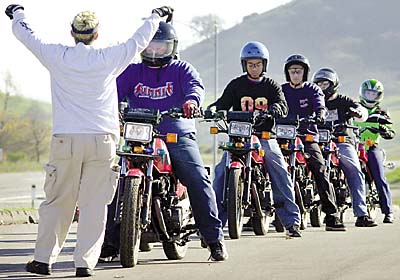
Despite large losses
– and impending cuts to its overall budget – Gavilan College
will not only keep its money-draining Community Education program
alive, it’s prepared to expand it, too.
But the school’s new president, Steve Kinsella, said changes
would not occur until a business plan to make Community Education
more profitable gets created first.
Despite large losses – and impending cuts to its overall budget – Gavilan College will not only keep its money-draining Community Education program alive, it’s prepared to expand it, too.
But the school’s new president, Steve Kinsella, said changes would not occur until a business plan to make Community Education more profitable gets created first.
Gavilan lost $89,350 in the last school year delivering classes outside its core academic curriculum. At a time when the college needs to trim $1.2 million from this year’s operating budget, the revenue loss casts a heavy shadow on Gavilan’s financial picture.
“People have talked about breaking even, but that’s got to be at a minimum,” Kinsella said. “I don’t want folks to settle on breaking even when we can use profits from … classes to use throughout the college.”
While two children’s programs within Community Education typically break even each year and specialized training offered to businesses has turned modest profits, times are bleak for the rest of the program.
Last year, Community Education programs not catering to children and businesses lost nearly $98,000, an imbalance almost $7,000 greater than that of 2000-01. In 1999-2000, when the economy was in slightly better shape, Community Education still endured a $111,000 shortfall.
The Community Education program is billed as a means for offering lifelong learning opportunities for community members. Classes offered through Community Education run the gamut of motorcycle riding courses to one-day self-improvement seminars. In a Community Education class, students are charged only nominal fees and, in most cases, costs for instruction and material are not picked up by the state.
Last year 3,795 students enrolled in 600 classes that were offered. In 2000-01, when the school’s overall Community Education program lost $30,000 less, only 4,777 students enrolled for 439 classes.
Kinsella said the $30,000 difference was largely because of the lack of businesses enrolling employees in specialized training classes at Gavilan from one year to the next.
“And that has a lot to do with the economy. When companies have to cut costs, one thing they typically cut back on is employee training,” Kinsella said. “In boom times, some companies hire people they like and train them later. In down times, they hire people who already have the skills, if they are even hiring anyone at all.”
Kinsella said he plans to develop by June a business plan for improving Community Education’s money-making potential. The plan could, among other things, outline which courses are offered elsewhere in the region and which courses can be offered within the core academic curriculum, where it can operate at a greater profit margin.
“In Community Education you have to be careful not to charge more than what your customers are willing to pay,” Kinsella said. “We don’t want to be competing against ourselves. And if we have competition elsewhere, we probably don’t want to duplicate that service.”
Kinsella was hired as president last fall, taking over Jan. 1 for Interim President Marty Johnson. Kinsella replaces Rose Marie Joyce, who left the school last summer to become president at Rio Hondo Community College in Whittier. Trustees said Kinsella was hired due to his financial expertise and ability to see the school through tight budget times.
Traffic school, computer skills courses and childcare classes are some of the programs Kinsella said have traditionally experienced a high demand and produced healthy revenue.
In her annual report to trustees last week, Community Education administrator Rachel Perez said the school’s motorcycle class takes in roughly $105,000 at nearly a 50-percent profit margin.
Perez said the popular class has room to expand the number of students it enrolls and can schedule more class sections if it takes advantage of daylight-saving time.
Costs of delivering courses continue to rise – even in the case of the motorcycle class, for which fuel prices jumped. Teacher salaries also have risen and don’t appear to be ready for a tapering off any time soon.
“It’s tough to convince, for instance, a qualified teacher who lives in San Jose to come to (Gavilan) unless you offer them competitive pay,” Perez said.
In addition to expanding the motorcycle course, the Community Education Department’s expansion plan calls for:
Increasing offerings by 25 new classes in all areas.
Expanding the children’s enrichment and academic programs to include winter and spring sessions.
Expanding business training to community agencies, not just businesses and industry.
Advertising online classes more aggressively.
Developing a seniors program.
Developing a foster care program.
Pursuing grants and other funding resources.
Perez asked trustees to consider the indirect benefits of having the Community Education program when it comes time to make cuts or add services.
“There are some intangibles you can’t measure when you look at what it provides for the community,” Perez said. “There are students who will take a Community Education course and then come back to Gavilan to take a credit course later because they had a good experience.”









